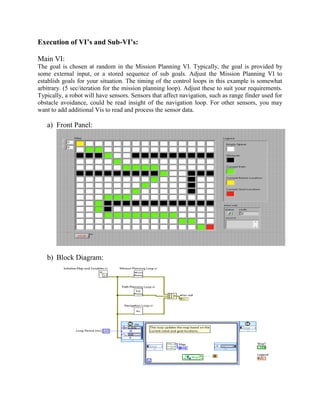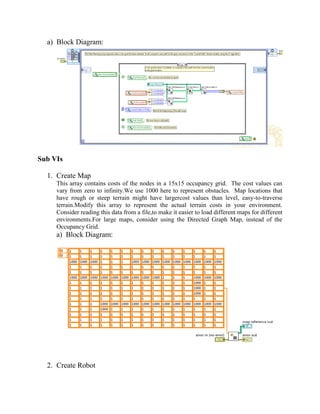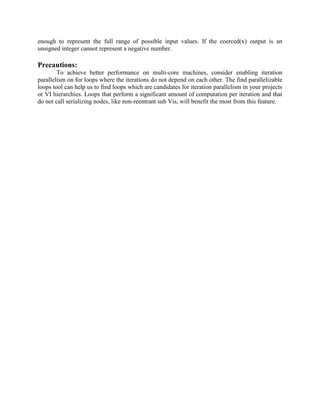Design the implementation of trajectory path of the robot using parallel loop algorithm
- 1. EXPERIMENT NO. 1 AIM: To study and design the implementation of trajectory path of the robot using parallel loop algorithm Apparatus Used: Microsoft Windows XP, Professional Version 2002, Intel® Pentium® Dual CPU. E2180 @2.00 GHz, 2.00 GHz, 199 GB of RAM, Lab VIEW Robotics 2011 SP1 Theory: LabVIEW (short for The Laboratory Virtual Instrumentation Engineering Workbench) is a platform and development environment for a visual programming language from National Instruments in which you create programs using a graphical natation(connecting functional nodes via wires through which data flows), in this regard, it differs from traditional programming languages like C, C++, or Java in which you program with text. However LabVIEW is much more than a programming language. It is an interactive program development and execution system designed for people, like scientists and engineers, who need to program as part of their jobs. The LabVIEW development environment works on computers running Windows, Mac OS X, or Linux. Labview can create programs that run on those platforms, as well as Microsoft Pocket PC Microsoft windows CE, Palm OS, and a variety of embedded platforms, including Field Programmable Gate Arrays (FPGAs), Digital Signal Processors (DSP), and Microprocessors. Procedure: Execution is determined by the structure of a graphical block diagram on which the programmer connects different function nodes by drawing wires. These wires propagate variables and any node can execute as soon as all its input data become available. Labview ties the creation of user interface (front panels) into the development cycle. Labview programs/subroutines are called virtual instruments (VIs). Each VI has three components; a block diagram, a front panel, and a connector panel. The last is used to represent the VI in the block diagram of other, calling vi. Controls and indicators on the front panel allow an operator to input data into or extract data from a running virtual instrument. However, the front panel can also serve as a programmatic interface. Thus a VI can either be run as a program, with the front panel serving as a user interface, or when dropped as a node onto the block diagram, the font panel defines the inputs and outputs for the given node through the connector pane. This implies each VI can be easily tested before being embedded as a subroutine into a larger program. The graphical approach also allows non-programmers to build programs simply by dragging and dropping virtual representation of lab equipment with which they are already familiar.
- 2. Execution of VI’s and Sub-VI’s: Main VI: The goal is chosen at random in the Mission Planning VI. Typically, the goal is provided by some external input, or a stored sequence of sub goals. Adjust the Mission Planning VI to establish goals for your situation. The timing of the control loops in this example is somewhat arbitrary. (5 sec/iteration for the mission planning loop). Adjust these to suit your requirements. Typically, a robot will have sensors. Sensors that affect navigation, such as range finder used for obstacle avoidance, could be read insight of the navigation loop. For other sensors, you may want to add additional Vis to read and process the sensor data. a) Front Panel: b) Block Diagram:
- 3. 1. Mission Planning Loop The Mission Planning Loop establishes the "goal" of the robot. In this, we randomly compute a new goal whenever we've reached the last goal. This loop could be modified to iterate through a sequence of goals and use them as intermediate steps towards a larger goal. a) Block Diagram: 2. Navigation Loop The Navigation Loop drives the robot to the goal, using the steering API. We might extend this VI by reading sensors to gather data for an obstacle avoidance algorithm. Thiscould be done by reading the sensor data within this loop, or by creating another loop for sensorinputs. a) Block Diagram: 3. Path Planning Loop The Path Planning Loop uses a search algorithm to compute a path from the current robot locationto the goal location, whenever a new goal is selected.If you add obstacle avoidance to the Navigation Loop, you might consider extending this VI torecomputed a new path if the current one becomes untenable.
- 4. a) Block Diagram: Sub VIs 1. Create Map This array contains costs of the nodes in a 15x15 occupancy grid. The cost values can vary from zero to infinity.We use 1000 here to represent obstacles. Map locations that have rough or steep terrain might have largercost values than level, easy-to-traverse terrain.Modify this array to represent the actual terrain costs in your environment. Consider reading this data from a file,to make it easier to load different maps for different environments.For large maps, consider using the Directed Graph Map, instead of the Occupancy Grid. a) Block Diagram: 2. Create Robot
- 5. This VI creates a simple differential-steering framewith the steering API. This frame will be used inthe Navigation Loop. a) Block Diagram: 3. Draw a Robot Map This VI creates a2D array of colorcontrols, to showthe map of obstacles,goal, and path. a) Front Panel: b) Block Diagram: 4. Initialize map & variable
- 6. This VI initializes the various shared variables that areused for communications amongthe loops running inparallel. As part of this initialization, we create a map withsome obstacles, and choose an initial starting point andgoal location. a) Block Diagram: 5. Shared Variable Helper 6. Steer Robot:
- 7. On an actual robot, you would use the Steering VIs to command the motorsto turn and drive the robot appropriately. In this example, we just update thecurrent location along the path. a) Front Panel: b) Block Diagram: Result: In this experiment we implement the trajectory path of a robot using parallel loop algorithm. Here we use loops, three loops of them is mission planning loop, path planning and navigation loop. There three loops are merged in merged function. Merges error I/O clusters from different functions. This function looks for errors beginning with the error in zero parameter and reports the first error found. If the function founds no errors, it looks for warnings and returns the first warning found. If the function founds no warning, it returns no errors. Use exception control to treat what is normally an error as no error or to treat a warning as an error. There have another loop named timed loop. In timed loop, executes one or more sub diagrams, or frames, sequentially each iteration of the loop at the period you specify. Use the timed loop when you want to developVIs with multi range timing capabilities, precise timing, feedback on
- 8. loop execution, timing characteristics that change dynamically, or several levels of execution priority in mission planning loop we randomly compute a new goal whenever we have reached the last goal. The goal is provided by some external input, or a stored sequence of sub goals. Adjust the mission planning VI to establish goals for your situation. This loop could be modified to iterate though a sequence of goals and use them as intermediate steps towards a larger goal. The navigation loop drives the robot to the goal, using the steering API (Simulated in this example). We might extend this VI by reading sensors to gather data for an obstacle avoidance algorithm. This could be done by reading the sensor data within this loop, or by creating another loop for sensor inputs. And the path planning loop uses a search algorithm to compute a path from the current robot location to planning loop uses a search algorithm to compute a path from the current robot location to the goal location, whenever a new goal is selected. If you add obstacle avoidance to the navigation loop, you might consider extending this VI to re-compute a new path if the current one becomes untenable. Executes one or more sub diagrams, or frames, sequentially each iteration of the loop at the period we specify. Use the timed loop when we want to develop Vis with multi rate timing capabilities, precise timing, feedback on loop execution, timing characteristics that change dynamically, or several levels of execution priority. Create a static map with fixed obstacles for this experiment. Here an array contains costs of the nodes in a 15x15 occupancy grid. The cost values can vary from zero to infinity. We use 1000 here to represents obstacles. Map locations that have rough or steep terrain might have larger cost values than level, easy to traverse terrain. Modify this array to represent the actual terrain costs in your environment. Consider reading this data from a file, to make it easier to load different maps for different environments. For large maps, consider using the directed graph map, instead of the occupancy grid. In initialize map and variables initializes the various shared variables that are used for communications among the loops running in parallel. As part of this initialization, we created a map with some obstacles and choose an initial starting point and goal location. When we drag a shared variable from the project explorer window to the block diagram or placed a shared variable, you can set the node to obsolete or target relative.An obsolete shared variable node always connects to the shared variable on the target on which you created the shared variable. A target relative shared variable node always connects to the shared variable on the target on which you run the VI that contains the shared variable node. On an actual robot, you would use the steering Vis to command the motors to turn and drive the robot appropriately. In this example, we just update the current location along the path. In steer robot function, there have a function named ‘Range and Coerce Function’ which is used for steer the robot. This function compares the input data values according to the Boolean comparison rules. If the function is in compare aggregates mode, it returns the unchanged value of x in coerced(x) rather than a coerced value. The function considers each input array as a single aggregate object, similar to a cluster, where the first element is primary in the comparison. If x is greater than upper limit and the function is in compare elements mode (default), the function coerces x to the upper limit value. If x is less than lower limit and the function is in compare elements mode, the function coerces x to the lower limit value. In the case of numeric values, the upper limit, the lower limit, and x inputs do not have to be the same data type representation. If you wire a combination of signed and unsigned integers to the upper limit, x, and lower limit inputs of the In Range and Coerce function, the data type of the coerced(x) output must be large
- 9. enough to represent the full range of possible input values. If the coerced(x) output is an unsigned integer cannot represent a negative number. Precautions: To achieve better performance on multi-core machines, consider enabling iteration parallelism on for loops where the iterations do not depend on each other. The find parallelizable loops tool can help us to find loops which are candidates for iteration parallelism in your projects or VI hierarchies. Loops that perform a significant amount of computation per iteration and that do not call serializing nodes, like non-reentrant sub Vis, will benefit the most from this feature.








